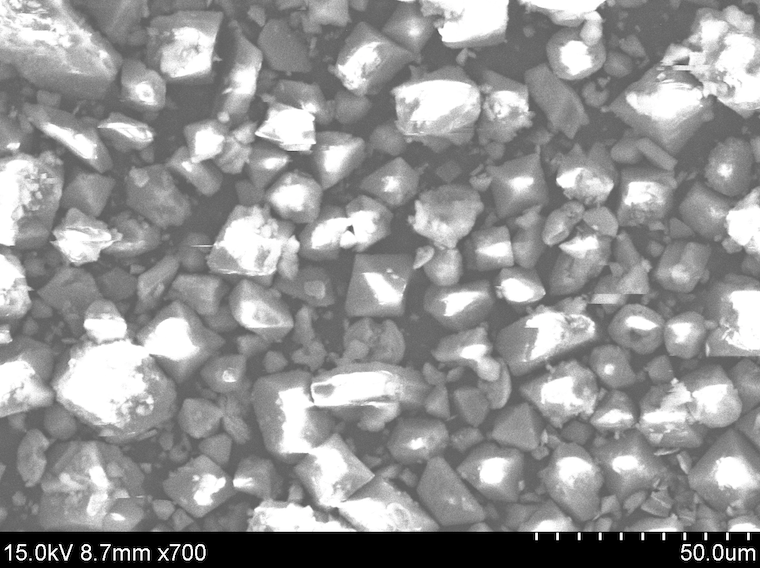Metal-Organic Frameworks (MOFs)—Open to the New World of "Porous Material"
Metal–organic frameworks (MOFs), built from the coordination of metal ions and organic ligands, possess defined and tunable structures at a molecular level. Owing to their unique properties like high surface areas, tunable pore sizes and multiple functionalities, MOFs have been widely studied and utilized in areas such as gas storage/separation, catalysis, magnetic material, and luminescence.1
Figure 1. SEM image of Cu3(BTC)2 MOF of ACS Material.
Cu3(BTC)2 (copper(II)-benzene-1,3,5-tricarboxylate), also known as HKUST-1, is a highly porous MOF composed of copper(II) and trimesate ions and has a bimodal pore size distribution. The larger pores have a diameter of approximately 0.9 nm and the smaller pockets have openings approximately 0.35 nm in diameter.2 The specific surface area of activated HKUST-1 from ACS Material can be as high as 1200 m2/g and its pore size is <1 nm since it is microporous. The compound is stable even at temperatures higher than 573K and it has been demonstrated that Cu3(BTC)2 possesses great potential for hydrogen storage, gas purification and separation, as well as a heterogeneous catalysis.3,4
Zeolitic imidazolate frameworks (ZIFs) are a new class of MOFs that have exceptional chemical and thermal stability and they are being evaluated for several applications, such as gas adsorption, molecular separation and catalysis.5 ZIF-8 (Zn(mim)2, mim=2-methylimidazolate) and ZIF-67 (Co(mim)2) are the most representative ZIF materials with a zeolite sod topology.6 In fact, Pan et al. have proposed a novel synthesis method for preparing ZIF-8 in aqueous solutions at room temperature that prohibits the use of toxic organic solvent.7
ZIF-67 is isostructural to ZIF-8 and is formed by bridging 2-methylimidazolate anions and cobalt cations to produce a sodalite (SOD) topology with a pore size of about 0.34 nm.8 Nevertheless, the similar structure and organic ligands makes ZIF-67 have a close formation mechanism with ZIF-8.9
Recently, MOFs were used as novel self-sacrificed templates for the preparation of nanostructured materials like porous carbons and metal oxides.10,11 This strategy is fascinating since carbons or metal oxides with extremely porous structures can be obtained directly from MOFs without extra templates. ACS Material offers Nitrogen-doped Graphitic Porous Carbon that is based on ZIF-8 as the template with extremely high surface area >1100 m2/g. The MOFs-derived materials are promising candidates in hydrogen storage, sensors, electrochemical capacitors and lithium ion batteries.12,13,14 ACS Material also offers Cu-BTC (HKUST-1), ZIF-8, ZIF-67 and Nitrogen-doped Graphitic Porous Carbon (NGPC) with high quality, uniform particle size and large specific surface area.
ACS Material Products:
- Metal-Organic Framework Cu-BTC (HKUST-1)
- Zeolitic Imidazolate Framework-8 (ZIF-8)
- Zeolitic Imidazolate Framework-67 (ZIF-67)
- Nitrogen-doped Graphitic Porous Carbon
References
1. Xia, Wei, et al. “Well-Defined carbon polyhedrons prepared from nano metal–organic frameworks for oxygen reduction.” J. Mater. Chem. A, vol. 2, no. 30, 2014, pp. 11606–11613., doi:10.1039/c4ta01656d.
2. Vishnyakov, Aleksey, et al. “Nanopore Structure and Sorption Properties of Cu−BTC Metal−Organic Framework.” Nano Letters, vol. 3, no. 6, 2003, pp. 713–718., doi:10.1021/nl0341281.
3. Schlichte, Klaus, et al. “Improved synthesis, thermal stability and catalytic properties of the metal-Organic framework compound Cu3(BTC)2.” Microporous and Mesoporous Materials, vol. 73, no. 1-2, 2004, pp. 81–88., doi:10.1016/j.micromeso.2003.12.027.
4. Gascon, Jorge, et al. “Manufacture of dense coatings of Cu3(BTC)2 (HKUST-1) on α-Alumina.” Microporous and Mesoporous Materials, vol. 113, no. 1-3, 2008, pp. 132–138., doi:10.1016/j.micromeso.2007.11.014.
5. Chen, Binling, et al. “Zeolitic imidazolate framework materials: recent progress in synthesis and applications.” J. Mater. Chem. A, vol. 2, no. 40, 2014, pp. 16811–16831., doi:10.1039/c4ta02984d.
6. Shi, Qi, et al. “Synthesis of ZIF-8 and ZIF-67 by Steam-Assisted Conversion and an Investigation of Their Tribological Behaviors.” Angewandte Chemie, vol. 123, no. 3, 2010, pp. 698–701., doi:10.1002/ange.201004937.
7. Pan, Yichang, et al. “Rapid synthesis of zeolitic imidazolate framework-8 (ZIF-8) nanocrystals in an aqueous system.” Chemical Communications, vol. 47, no. 7, 2011, p. 2071., doi:10.1039/c0cc05002d.
8. Banerjee, Rahul. “High-Throughput Synthesis of Zeolitic Imidazolate Frameworks and Application to CO2 Capture.” Science, vol. 319, no. 5865, 15 Feb. 2008, pp. 939–943., doi:10.1126/science.1152516.
9. Qian, Junfeng, et al. “Hydrothermal synthesis of zeolitic imidazolate framework-67 (ZIF-67) nanocrystals.” Materials Letters, vol. 82, 2012, pp. 220–223., doi:10.1016/j.matlet.2012.05.077.
10. Yang, Seung Jae, et al. “Preparation and Exceptional Lithium Anodic Performance of Porous Carbon-Coated ZnO Quantum Dots Derived from a Metal–Organic Framework.” Journal of the American Chemical Society, vol. 135, no. 20, Sept. 2013, pp. 7394–7397., doi:10.1021/ja311550t.
11. Kim, Tae Kyung, et al. “Nanoporous Metal Oxides with Tunable and Nanocrystalline Frameworks via Conversion of Metal–Organic Frameworks.” Journal of the American Chemical Society, vol. 135, no. 24, Apr. 2013, pp. 8940–8946., doi:10.1021/ja401869h.
12. Jiang, Hai-Long, et al. “From Metal–Organic Framework to Nanoporous Carbon: Toward a Very High Surface Area and Hydrogen Uptake.” Journal of the American Chemical Society, vol. 133, no. 31, Oct. 2011, pp. 11854–11857., doi:10.1021/ja203184k.
13. Zhang, Lei, et al. “Formation of Fe2O3 Microboxes with Hierarchical Shell Structures from Metal–Organic Frameworks and Their Lithium Storage Properties.” Journal of the American Chemical Society, vol. 134, no. 42, 2012, pp. 17388–17391., doi:10.1021/ja307475c.
14. Zhao X, Yang H, Jing P, et al. "A Metal–Organic Framework Approach toward Highly Nitrogen–Doped Graphitic Carbon as a Metal–Free Photocatalyst for Hydrogen Evolution". Small, 2016, doi: 10.1002/smll.201603279.
